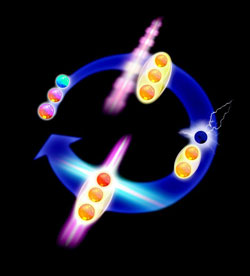The quantum computer is growing up

The quantum bit (blue) is entangled with the auxiliary qubits (red). If an error occurs, the state of the defective quantum bit is corrected.<br>Graphics: Harald Ritsch<br>
A team of physicists at the University of Innsbruck, led by Philipp Schindler and Rainer Blatt, has been the first to demonstrate a crucial element for a future functioning quantum computer: repetitive error correction. This allows scientists to correct errors occurring in a quantum computer efficiently. The researchers have published their findings in the scientific journal Science.
A general rule in data processing is that disturbances cause the distortion or deletion of information during data storage or transfer. Methods for conventional computers were developed that automatically identify and correct errors: Data are processed several times and if errors occur, the most likely correct option is chosen.
As quantum systems are even more sensitive to environmental disturbances than classical systems, a quantum computer requires a highly efficient algorithm for error correction. The research group of Rainer Blatt from the Institute for Experimental Physics of the University of Innsbruck and the Institute for Quantum Optics and Quantum Information of the Austrian Academy of Sciences (IQOQI) has now demonstrated such an algorithm experimentally. “The difficulty arises because quantum information cannot be copied,“ explains Schindler. “This means that we cannot save information repeatedly and then compare it.“ Therefore, the physicists use one of the peculiarities of quantum physics and use quantum mechanical entanglement to perform error correction.
Quick and efficient error correction
The Innsbruck physicists demonstrate the mechanism by storing three calcium ions in an ion trap. All three particles are used as quantum bits (qubits), where one ion represents the system qubit and the other two ions auxiliary qubits. “First we entangle the system qubit with the other qubits, which transfers the quantum information to all three particles,” says Philipp Schindler. “Then a quantum algorithm determines whether an error occurs and if so, which one. Subsequently, the algorithm itself corrects the error.“ After having made the correction, the auxiliary qubits are reset using a laser beam. “This last point is the new element in our experiment, which enables repetitive error correction,“ says Rainer Blatt. “Some years ago, American colleagues demonstrated the general functioning of quantum error correction. Our new mechanism allows us to repeatedly and efficiently correct errors.“
Leading the field
“For a quantum computer to become reality, we need a quantum processor with many quantum bits,“ explains Schindler. “Moreover, we need quantum operations that work nearly error-free. The third crucial element is an efficient error correction.“ For many years Rainer Blatt’s research group, which is one of the global leaders in the field, has been working on realizing a quantum computer. Three years ago they presented the first quantum gate with fidelity of more than 99 percent. Now they have realized another key element: repetitive error correction.
This research work is supported by the Austrian Science Fund (FWF), the European Commission, the European Research Council and the Federation of Austrian Industries Tyrol and is published in the scientific journal Science.
Publication: Experimental repetitive quantum error correction. Philipp Schindler, Julio T. Barreiro, Thomas Monz, Volckmar Nebendahl, Daniel Nigg, Michael Chwalla, Markus Hennrich, Rainer Blatt. Science, 27 May 2011. DOI: 10.1126/science.1203329
Contact:
Philipp Schindler
Institute for Experimental Physics
University of Innsbruck
Phone: +43 512 507-6328
Email: philipp.schindler@uibk.ac.at
http://www.quantumoptics.at/
Christian Flatz
Public Relations
University of Innsbruck
Phone: +43 512 507-32022
Mobil: +43 676 8725 32022
Email: christian.flatz@uibk.ac.at
Media Contact
All latest news from the category: Physics and Astronomy
This area deals with the fundamental laws and building blocks of nature and how they interact, the properties and the behavior of matter, and research into space and time and their structures.
innovations-report provides in-depth reports and articles on subjects such as astrophysics, laser technologies, nuclear, quantum, particle and solid-state physics, nanotechnologies, planetary research and findings (Mars, Venus) and developments related to the Hubble Telescope.
Newest articles

Silicon Carbide Innovation Alliance to drive industrial-scale semiconductor work
Known for its ability to withstand extreme environments and high voltages, silicon carbide (SiC) is a semiconducting material made up of silicon and carbon atoms arranged into crystals that is…

New SPECT/CT technique shows impressive biomarker identification
…offers increased access for prostate cancer patients. A novel SPECT/CT acquisition method can accurately detect radiopharmaceutical biodistribution in a convenient manner for prostate cancer patients, opening the door for more…

How 3D printers can give robots a soft touch
Soft skin coverings and touch sensors have emerged as a promising feature for robots that are both safer and more intuitive for human interaction, but they are expensive and difficult…





















